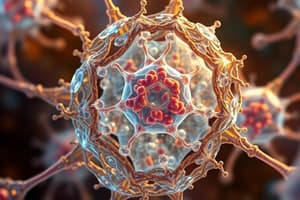Podcast
Questions and Answers
Who invented the first microscope?
Who invented the first microscope?
Zacharias Janssen
What did Robert Hooke observe under the microscope in 1665?
What did Robert Hooke observe under the microscope in 1665?
Box-shaped structures (cells)
Who is considered the Father of Microbiology?
Who is considered the Father of Microbiology?
Anton van Leeuwenhoek
Which scientist stated that all living things are made up of cells?
Which scientist stated that all living things are made up of cells?
All cells are identical in structure and chemical composition.
All cells are identical in structure and chemical composition.
What structure is responsible for producing ATP?
What structure is responsible for producing ATP?
Which of the following plant cell structures is responsible for photosynthesis?
Which of the following plant cell structures is responsible for photosynthesis?
Match the following cellular structures with their functions:
Match the following cellular structures with their functions:
What is the main function of the vacuole in plant cells?
What is the main function of the vacuole in plant cells?
What is meant by cell specialization?
What is meant by cell specialization?
Which type of cell lacks a nucleus?
Which type of cell lacks a nucleus?
Flashcards are hidden until you start studying
Study Notes
Cell Discovery Timeline
- 1590: Zacharias Janssen invented the first microscope for magnification of small objects.
- 1665: Robert Hooke identified box-shaped structures called cells while observing cork.
- 1674: Anton van Leeuwenhoek discovered "animalcules" in pond water, establishing himself as the Father of Microbiology.
- 1838: Matthias Schleiden concluded that all plants are composed of cells.
- 1839: Theodor Schwann established that all animals are composed of cells.
- 1855: Rudolf Virchow proposed that cells arise from pre-existing cells through cell division.
Cell Theory
- Asserts that all living organisms consist of cells.
- Cells are the fundamental units of structure and function in organisms.
- Cells originate from other cells, embodied by the phrase "Omnis cellula e cellula."
- Cells transmit genetic material during division.
- All cells share similar structural and chemical characteristics.
- Biochemical processes responsible for energy flow take place within cells.
Cell Structures
- Organelles: Specialized structures within cells that perform essential functions for cellular life.
- Cell Membrane: A thin, double-layered structure that regulates material passage in and out of the cell.
- Cell Wall (Plants): A rigid layer made of cellulose that provides protection and structural support.
- Nucleus: A membrane-bound organelle storing DNA, regulating cell activities, and synthesizing ribosomes and proteins.
- Nucleolus: Found inside the nucleus, it produces and assembles ribosomes.
- Ribosome: Large complexes of protein and RNA; the site of protein synthesis.
- Mitochondrion: Double-membraned organelles that generate ATP, the cell's energy currency.
- Endoplasmic Reticulum: Interconnected membranous sacs; can be rough (with ribosomes, alters proteins) or smooth (synthesize lipids, detoxifies substances).
- Golgi Body: Processes, sorts, and packages proteins and lipids for distribution.
- Lysosome (Animals): Contains digestive enzymes; involved in nutrient digestion and organelle recycling.
- Chloroplast (Plants): Disc-shaped organelle responsible for photosynthesis, containing chlorophyll.
- Vacuole (Plants): Large fluid-filled organelle maintaining water balance and storing nutrients and waste.
- Cytoskeleton: A protein filament network providing structure, movement, and facilitating cell division.
Major Cell Types
Prokaryotic Cells
- Simple, unicellular organisms without a nucleus or membrane-bound organelles; DNA is found in a nucleoid region.
Eukaryotic Cells
- More complex organisms with a nucleus enclosed by a membrane and other membrane-bound organelles.
Types of Tissues
- Epithelial Tissue: Covers body surfaces and lines organs; characterized by tightly joined cells.
- Connective Tissue: Supports and connects various parts of the body (blood, cartilage, bone).
- Muscle Tissue: Composed of muscle fibers for voluntary and involuntary movements (skeletal, cardiac, smooth).
- Nerve Tissue: Made of neurons and glial cells; conducts electrical signals in the body.
Cell Specialization (Cell Differentiation)
- Generic cells transform into specialized types to perform specific functions.
Specialized Cells in Animals
- Red Blood Cell: Carries oxygen, lacks a nucleus, and has a biconcave shape.
- White Blood Cell: Key player in the immune system, irregularly shaped, produces antibodies.
- Sperm Cell: Fertilizes eggs, has a tail for movement, contains mitochondria for energy.
- Egg Cell: Carries genetic material, large size, and prevents fertilization by multiple sperm.
- Nerve Cell: Transmits impulses with long axons and branching dendrites.
- Muscle Cell: Facilitates movement, elongated structure with many mitochondria.
Specialized Cells in Plants
- Guard Cell: Regulates transpiration with a variable cell wall thickness.
- Root Hair Cell: Absorbs water and minerals, elongated for increased surface area.
- Photosynthetic Cells: Perform photosynthesis with numerous chloroplasts.
- Xylem Vessel: Transports water; formed as a continuous tube without protoplasm.
Cell Modification
- Adaptations developed post-division for various beneficial functions.
- Cilia: Hair-like extensions for movement or sensory functions.
- Flagella: Whip-like structures aiding cell movement.
- Villi/Microvilli: Finger-like projections enhancing absorption surface.
- Pseudopods: Temporary extensions used for movement and phagocytosis (ingestion).
Studying That Suits You
Use AI to generate personalized quizzes and flashcards to suit your learning preferences.




